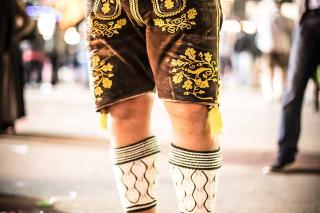Lederhosen: seven facts that hardly anyone knows
No Oktoberfest without Lederhosen. For tradition-conscious men, this legwear is almost obligatory. Did you know why Lederhosen are actually functional clothing, that they were once considered immoral and what a man wears underneath? Here is plenty of material for small talk in the beer tent.

1. Lederhosen belong to Bavaria - but not only
When you think of Lederhosen, you inevitably think of Bavaria. And of course it's true that this type of trousers has a tradition especially in Germany's largest state - but not only. Other Alpine peoples such as Austrians, Swiss and South Tyroleans also love to wear Lederhosen. So the Krachledernen are not a purely Bavarian phenomenon.
2. Much more than fair weather pants
Maybe it sounds exaggerated to call Lederhosen functional clothing, but they can definitely do more than most people think. The deerskin is pleasantly soft and makes the pants robust and durable at the same time. They protect against harsh weather, keep you warm in the cold and cool in the heat. They also tolerate liquids like rain or beer quite well. So somehow functional clothing after all.

3. No clerical blessing for the Lederhosen
At least the Catholic Church does not like Lederhosen very much. For this reason, they are still taboo in some church buildings during services. In 1913, the Archbishop of Munich even officially declared them "immoral. However, the handling of Lederhosen today is also often made more tolerant. It is even allowed to get married in Lederhosen.
4. The Lederhosen industry: a global business
The worldwide production of Lederhosen is booming. Many Lederhosen factories are located in India, Hungary or Sri Lanka, the leather used often comes from Pakistan or New Zealand. Who wants to have a genuine Hirschlederne from domestic leather, should go to a renowned traditional costume store with tradition and must accordingly spend a lot more money. But then the Hirschlederne lasts a lifetime.
5. Well on it in Lederhosen. And underneath?
This question is one of the biggest mysteries surrounding Lederhosen: do you wear them with or without underpants? The Lederhosen are supposed to fit crisply, and sometimes there really isn't much room for underwear because of that, at least not boxer shorts with a lot of fabric. Today, the briefs question is a matter of taste, but until the forties it was different. Then one wore the Lederhosen basically "bottomless".
6. Next exit Lederhosen
There are strange place names everywhere. The people of Brandenburg have their "Kotzen", Rhineland-Palatinate has "Busenhausen" and the people of Thuringia have "Lederhose". The town you pass when traveling south on the A9 from Leipzig has 267 inhabitants, a daycare center and an industrial park. And it has a cool name.
7. Leather Cult in Hamburg
Lederhosen are also popular in the Hanseatic city. But not in the way you might think. We're not talking about the flashy leather outfits that you inevitably see on the Reeperbahn. We're talking about Hamburg's police dog handlers, who always wear leather trousers instead of cloth pants.

6. Nächste Ausfahrt Lederhose
Kuriose Ortsnamen gibt es überall. Die Brandenburger haben ihr „Kotzen“, Rheinland-Pfalz hat „Busenhausen“ und die Thüringer haben eben „Lederhose“. Der Ort, den man passiert, wenn man von Leipzig gen Süden auf der A9 unterwegs ist, hat 267 Einwohner, eine Kindertagesstätte und ein Gewerbegebiet. Und eben einen coolen Namen.
7. Leder-Kult in Hamburg
Lederhosen sind auch in der Hansestadt angesagt. Aber nicht so, wie man jetzt denken könnte. Gemeint sind nicht die schrillen Lederoutfits, die man auf der Reeperbahn zwangsläufig sieht. Gemeint sind die Hamburger Polizeihunddienstführer, die ihren Dienst grundsätzlich in Leder- statt Stoffhose versehen.
